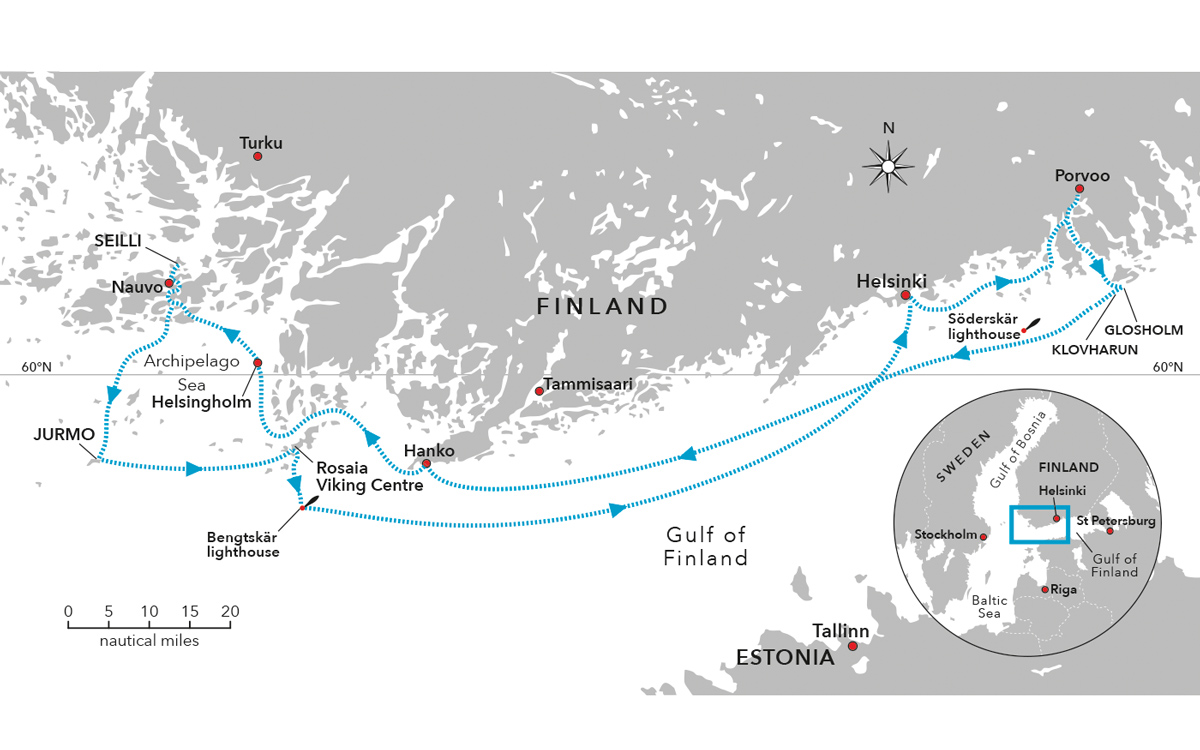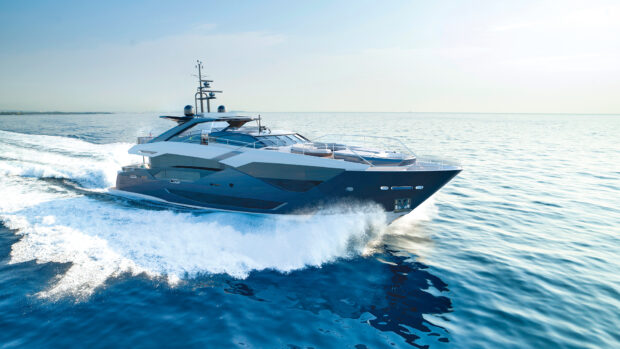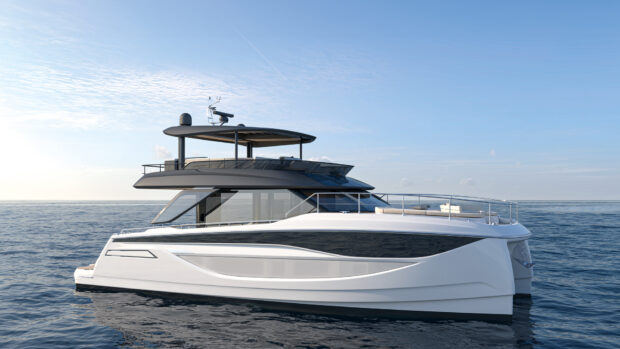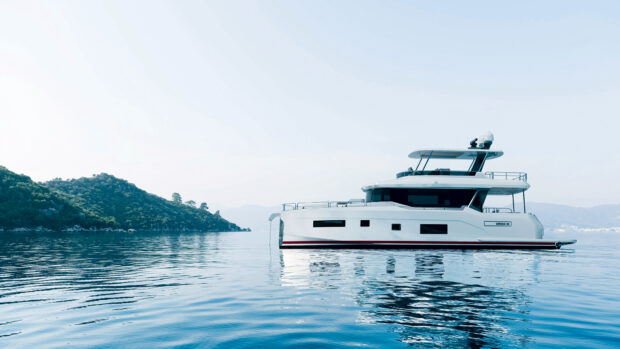Fairline owner Kivikari Freyberg spent a memorable six weeks cruising Finland’s Archipelago Sea and exploring its 17,000 islands with his young family...
We consider ourselves fortunate to have been born on the shores of Lake Saimaa in eastern Finland. For a boating enthusiast, Lake Saimaa with its 5,500 islands offers a cruising environment unlike anywhere else in the world. With waters pure enough to drink and islands so plentiful you are guaranteed to find one for yourself, it truly deserves to be called a hidden gem.
My early years were spent exploring this amazing place in my parents’ boats. Later, when finances allowed, my brother and I bought our own boat, a 34ft locally built Tristan Harmony cruiser. She was followed by a Sealine F37, which my brother and I motored back from London.
Four years later my brother decided to stop boating for family reasons, which left me, my wife, two kids (aged 4 and 3 at the time) searching for a boat of our own. We settled on a Fairline Phantom 43, which we bought in Lymington and shipped back to Finland in 2012, writing a story about it for this very magazine (Finnishing School – MBY May 2013).

Kivi shipped his Fairline Phantom 43 from the UK to Finland
More years of cruising on the Lake Saimaa followed but as we could now spend longer onboard, the idea of cruising further afield started to appeal. We knew that the Archipelago Sea National Park in the south-west of Finland was another special cruising area but what little first-hand experience we had of it was from the top deck of a passenger ferry.
Island life
We had heard of this area’s unique island culture where close-knit fishing communities eke out a living in challenging circumstances but also of the beauty of the countless islands and myriad anchorages. We started researching the area and came to the conclusion that we would need more than the usual two weeks to explore even a fraction of its 8,300km2 and 17,000 islands. The thought of cruising into the open sea added an extra element of excitement to our planning.
Despite our reservations, we decided to give it a go for a season and see how we got along. The plan was to take the boat to Helsinki to get acquainted with our new environment before starting the holiday cruise proper. We approached the Helsinki Motorboat Club, right in the heart of the city, which arranged a terrific berth for us with a view of Uspenski Cathedral.
Article continues below…

Cruising Denmark: Scandinavian cruising grounds perfectly designed for boating

Cruising Norway: Exploring Stavanger Bay and beyond
In our latest feature, Peter Cumberlidge explains why Stavanger Bay is the perfect starting point for boaters interested in cruising
Spending a few weekends cruising the waters around here also gave us a chance to talk to local boaters about the best places to visit and get an idea of how things work in the archipelago. We had a rough plan of the places we wished to visit but deliberately left it open to keep things relaxed and avoid the pressures of a set schedule. We were fortunate to be able to take six weeks off work but to avoid any feelings of cabin fever we agreed that we could take a break from the cruise at any point if we chose to.
Midsummer Night’s Dream
On Midsummer’s Eve we arrived at the boat, unloaded the car and trailer, and cast off. Our first port of call was our friend’s cabin in Porvoo, a leisurely two-hour cruise to the east of Helsinki, where we had a wonderful time enjoying long lazy meals al fresco interspersed with repeat visits to their lakeside sauna.
We enjoyed a day trip to the island of Klovharun, where Tove Jansson spent her summers writing the Moomin books. We also visited the nearby island of Glosholm, which used to host a small lighthouse that was the inspiration for the Moomin’s house.

After bidding farewell to our friends, we set a course west towards our ultimate goal some 200nm away. As our next destination was well west of Helsinki and the sea was benign, I thought it would be a good idea to head out into open sea and get a feel of our new environment.
We made our way out of the shelter of the islands, waved to the lighthouse at Söderskär and entered open waters before turning west. As we headed further out our initial trepidation started to ease and my wife made a comment I shall never forget; she smiled and said “this is actually quite fantastic”. I can’t tell you how happy it made me to hear her utter those words.
The first destination on our proposed route was Hanko, a small city on the southwest tip of mainland Finland. It’s almost as if the retreating ice-age glaciers had tried to make amends by carving out this sandy peninsula, the beaches of which have been enjoyed by affluent Helsinki residents since the late 19th century, when the first spa and casino were built. Period villas still line the beach, many of them offering accommodation for visiting tourists.

Every island is unique
Hanko is also a bit of a hot spot when it comes to boating. A new marina has been built on a group of small skerries just across from the city centre with berths for around 300 boats, complete with water, electricity, laundry facilities, a restaurant and three saunas. Together with another marina on the mainland side, there is quite a buzz. Thankfully, as it was still early in the season, we had no problems finding a berth.
We spent a couple of days walking around the town, enjoying beach life and the holiday vibe. Hanko Regatta, a big sailing event due to take place the following weekend, saw an increasing number of boats gathering in the marina. As we knew things were likely to get a bit lively, we decided to continue our cruise further west towards Turku.
The plan was to get a first taste of the Archipelago Sea by crossing its north-eastern corner along the way. We stopped for a night at Helsingholm, a small island occupied by a family of three, who make their living from fishing, farming and running a small but very popular marina.

Helsingholm’s simple, pastoral charm provides a nice contrast to fashionable Hanko
In complete contrast to the swankiness of Hanko, this small island perfectly presented the more traditional archipelago culture, with a slower way of life that is adapted to the environment and changing seasons. However, the true charm of the place lies in its people. The owners wake up early each morning to fill a small kiosk with fresh produce for boaters to purchase then go about their business of maintaining the place, preparing for fishing trips and so on.
Sauna with a view
As we had tied up to the last remaining free berth, we walked to the office to pay our fees and see what we could purchase from the kiosk. Being new to the place, we were looking for someone to pay, until we noticed an open honesty box complete with change for any big notes. We spotted another box on the side of the building for berthing fees. We loved the atmosphere and thought it said a lot about life in the archipelago, where things are based on trust and looking after your fellow mariners.
The place has another ace up it’s sleeve too. The sauna is widely regarded as one of the most beautiful in Finland. Perched on a low cliff, sheltered by equally low pines and with access to its own private beach, it is nothing short of paradise.

Saunas are a key part of Finnish boating culture…
Saunas are a key part of Finland’s boating culture. It’s where people gather at the end of the day to wash off the salt and exchange stories of the day’s cruising. No marina worth its salt (excuse the pun) is complete without one. There are usually designated visiting times for men and women, outside of which it can be booked for a family or group of friends.
Sat in the gentle heat of the sauna and stripped off branded clothing and other trappings of status, no one knows if your boat is powered by wind or engines and worth a few thousand or a few million. It is a wonderfully leveller and its health benefits, both physical and mental, have been widely documented too.
We wholeheartedly agree with the experts’ findings and booked the sauna for ourselves the following day. After several trips from the sauna to the sea and back, we sat on the cliff in the late afternoon sun and felt utterly relaxed and at one with the world.

…and the best ones come with spectacular views included
At the beginning of our cruise, the weather had been quite cold and rainy but it had steadily improved each day. Now we continued our cruise in perfect sunshine and with just enough wind to make the sea sparkle like diamonds as we made our way between the islands and skerries.
Although I was slowly gaining confidence in navigating this new environment, I had to stay focused. The routes are well marked with buoys and marker posts but just a few metres either side of the channel I could see the dark shadows of rocks lurking just below the surface and wave patterns suggesting hidden shallows. I shuddered at the thought of navigating here with just a compass and a hand-drawn map, as the ancient mariners once did – no wonder the Archipelago Sea is a wreck diver’s paradise.
What lies beneath
We arrived at Nauvo, our destination for the day, in the late afternoon. Nauvo is a boating hub at the northern end of the Archipelago Sea, some 20 miles south of Turku. I had phoned ahead and was told that the place was full, but I thought it would be worth poking our nose into the marina to see if the situation had changed.

The picture perfect anchorage at Seili surrounded by lush meadows and grazing cows
It hadn’t, so we started preparing ourselves for a night on anchor in a bay on the west side of a small island, called Seili. The weather couldn’t have been more perfect for our first night on the hook with no wind and not a cloud in the sky. We managed to find a picture perfect spot; a shallow, sheltered bay with good holding surrounded by a lush green meadow where cows grazed contentedly.
After settling down for the evening, I spotted some old buildings and a small church with a cemetery a little way apart from the others. As they looked out of place on such a small island, I looked up the history of the place. And boy, what a history it has. Originally set up as a leper colony in the 17th century, it later became an asylum. In the early days, the patients were allowed to distill moonshine, which they sold to passing sailors leading to yet more unrest.
It seemed to sum up life on an island, from where, once admitted, few ever returned. I decided to keep this information to myself for the evening but in the morning we launched our dinghy and rowed ashore to investigate.

The church with a dark history to tell
The stories set our imaginations racing, as we toured the hospital grounds, today occupied by the University of Turku, and visited the church. As beautiful and peaceful as it was, the atmosphere couldn’t escape the ghosts of its troubled past, in our minds at least, so it felt good to up the anchor and head to Turku for a couple of nights of city living.
Ice sculptures
We ended up staying there for a whole week, which was not only fun but also allowed the crew to do some shopping and enjoy the comforts of ‘civilisation’. As the weather continued to bless us, the lure of the open sea started calling again. We had heard stories of an interesting island called Jurmo on the southernmost edge of the archipelago, so we plotted a route right across the National Park.
We departed the Aura river in glorious sunshine, leaving Turku Castle behind while admiring the beautiful old villas that line the island waterfront. Reaching the large open body of water known as Aristo, we eased the boat to its cruising speed of 22 knots. It felt great to be on the water again, heading towards sunshine and open sea with the engines trundling away in the background and the summer breeze cooling us down on the flybridge.

With no fixed schedule and plenty of time the whole family enjoyed life aboard
After crossing the 60th latitude, the distinctive shape of Jurmo started to appear on the horizon. Another formation carved out of rock during the ice age, the island consists of a long low ridge that seems to rise and fall seamlessly from the sea. Slightly nervous of whether we’d find a berth, we approached the small marina and made two almost 90° turns to enter the basin.
We had timed our approach well, as there were a few boats leaving as we arrived. As with most marinas in Finland, the mooring arrangement was a pontoon with buoys on either side. You pick up a buoy at your stern as you go in then tie your bow to the pontoon. Most local boats have an open pulpit allowing you step on and off but wriggling through the bow rails of our Fairline is not very dignified so we moored up stern-to instead.
After lunch on board, we went ashore to get a feel of the place. The marina has a small shop/café on the jetty and a pair of saunas but not much more. It is the natural habitat, however, that makes this place special. As you gaze south-west from the only high point, a sizeable cliff in the middle, the tip of the island emerges from the sea some 2km away.

Kivi’s wife Satu takes the helm
With no trees and only low-lying vegetation able to cling to this barren landscape, it feels like another world. We spent several days enjoying this otherworldly scenery where time seemed to slow and the day’s schedule revolved around morning strolls, afternoon naps and evenings in the cockpit enjoying a glass of wine beneath spectacular sunsets.
However, there was one more destination on our bucket list, the spectacular lighthouse at Bengtskär. We enjoyed an easy 30-mile cruise east to the Rosala Viking Center, where a Viking village has been reconstructed based on local archaeological excavations. Learning about their way of living made me once again spare a thought for the poor navigators, whose job it was to keep the boats safe or face the chieftain’s wrath.
Look up Rosala, Finland on Google Maps and you’ll soon see how challenging this must have been. Thankfully, I didn’t have to worry about my skull being turned into a drinking vessel as I had two plotters and the advice of a local fisherman to guide me through the maze of skerries to the last destination of our trip, Bengtskär Lighthouse.

The kids helped row the family ashore to visit the spectacular 52m-high lighthouse
Homeward bound
We cast off early in the morning, and island by island, we zigzagged south. With not a cloud in the sky and barely a ripple on the sea we pressed on. Slowly the skerries thinned out until the shape of the lighthouse appeared on the horizon.
Knowing that the waters around the lighthouse were not ideal for anchoring (too deep and rocky) we were prepared to just cruise by and admire it from the sea. However, as the conditions were mirror-calm, we decided to take our chances in the hope of finding suitable holding.
In the end I think the weight of the anchor chain alone was enough to keep us stationary. We boarded the tender and the kids rowed us ashore to the granite rocks polished smoothed by the pounding of the sea over thousands of years.

Anchored in mirror-calm conditions off Bengtskär
The lighthouse soars 52m above sea level, the tallest in Scandinavia. Today it serves as an exclusive hotel. Despite the heat, the view from the top more than made up for our exertions. The sauna at the back of the building is also claimed to be one of the oldest in the country, perhaps because its meter-thick granite walls are impervious to the fires that have claimed so many others.
Leaving Bengtskär in our wake we continued our gentle cruise back home, where we arrived a week later. After washing down our trusty Fairline, it was time to reflect on the past six weeks and 500nm. Everyone was safe and well, we hadn’t hit anything and we’d made a decade’s worth of memories.
My wife commented that she could have happily carried on for longer and the kids loved the time we’d spent together as a family. The boat didn’t put a foot wrong and at 43ft seems to be just the right size to find space even in the smaller marinas we visited.
To top it all off, everyone we’d met was friendly and in the same laid-back holiday mood. Our cruise was a complete success and while six weeks was long enough to get a feel for the area, the more we’d seen of it, the more we realised we’d missed. We decided then and there that we’d be back again soon.
First published in the November 2020 issue of Motor Boat & Yachting.

The spiral staircase leading up to the light itself

The view from the top justified the long climb up

Swinging at anchor in another perfect bay on the island of Aspö en route to Jurmo

Flat calm waters and miles of open sea allowed both the boat and the Freyberg family to stretch their cruising legs

Steps lead down into the gin-clear waters off Helsingholm

Snugly berthed on a pontoon in Korpoo during an overnight stop

Kivi’s temporary home berth in the heart of Helsinki

Enjoying a leisurely family meal aboard










